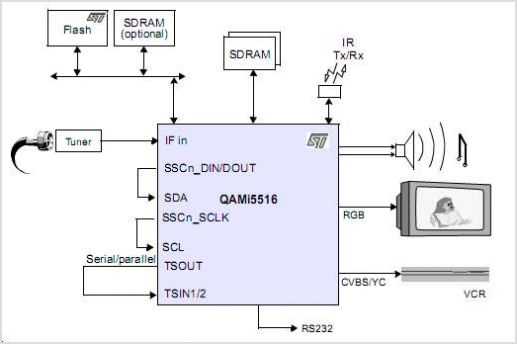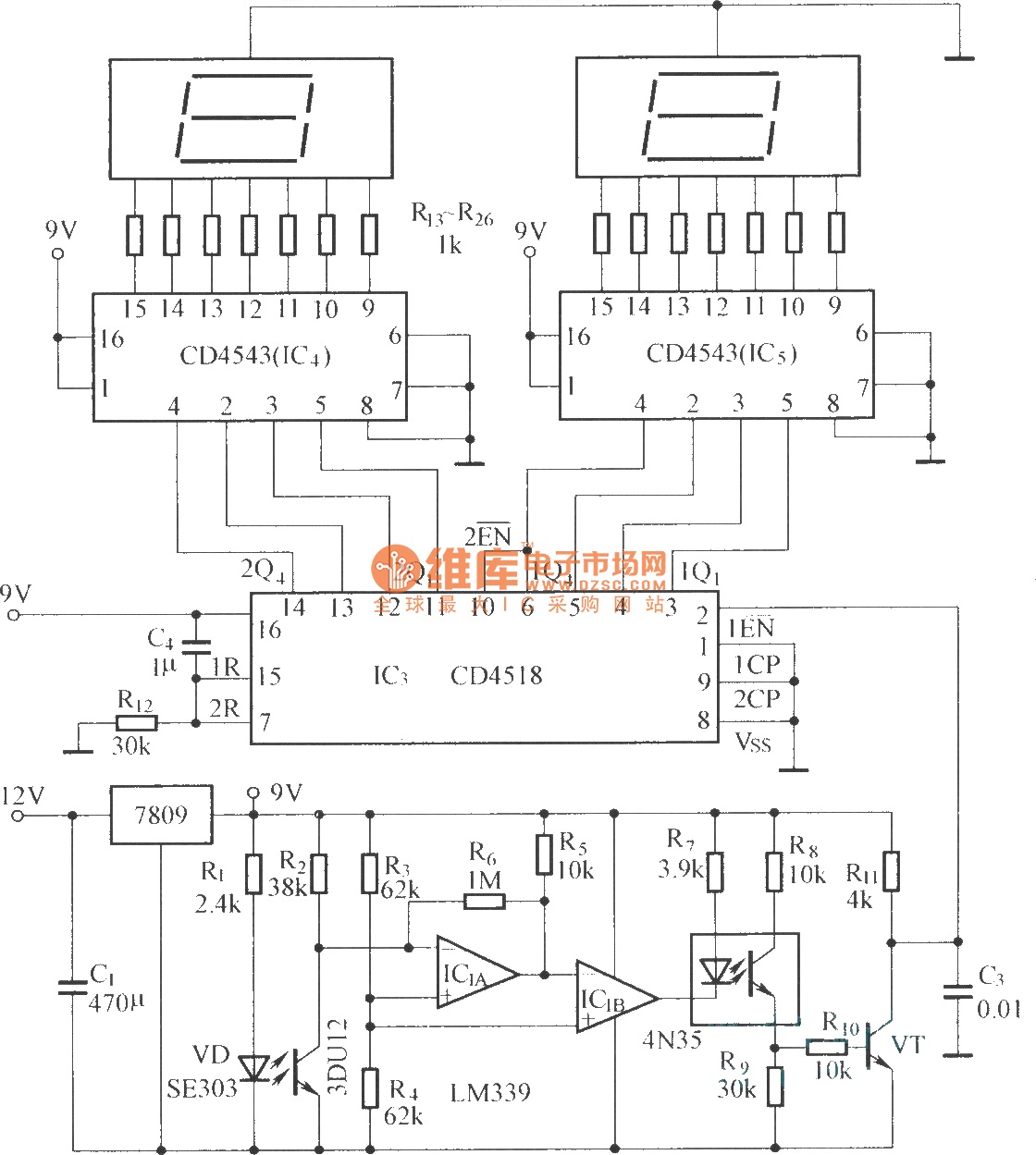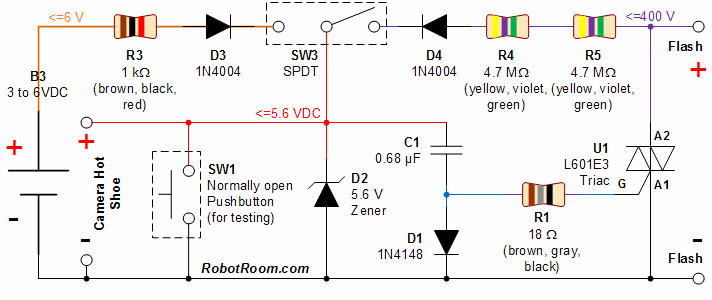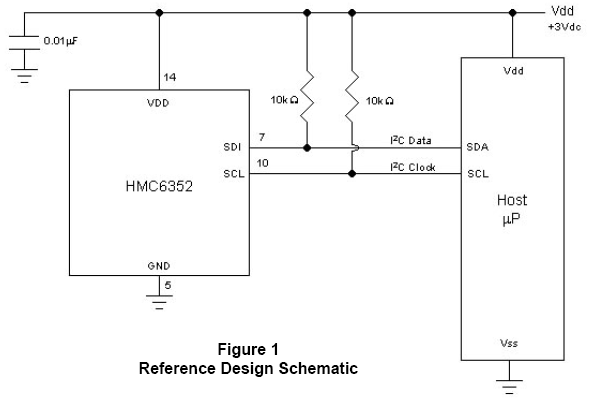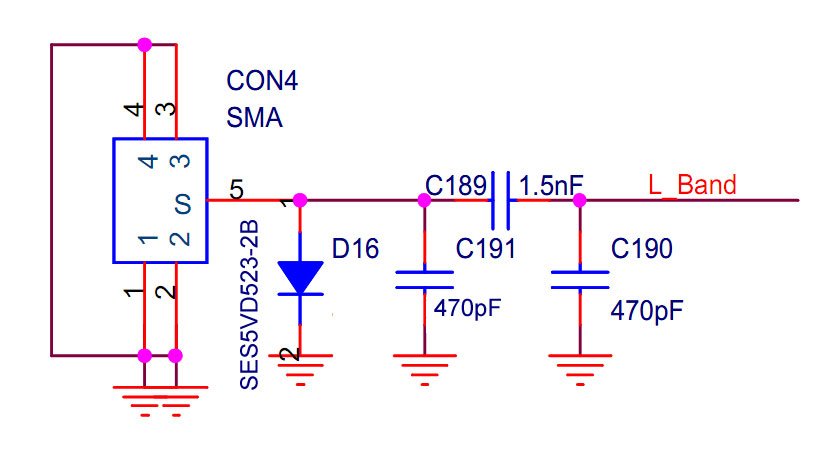
Digital Step-Km Counter
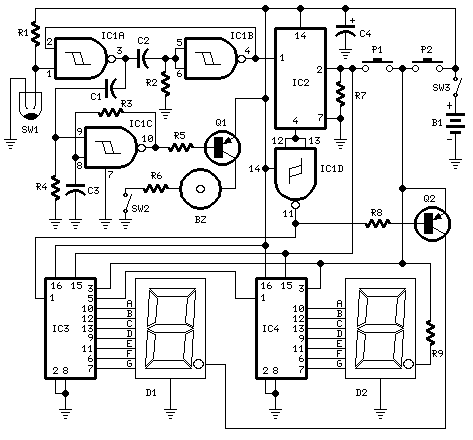
Hardware is located in a small box slipped in pants pocket and the display is conceived in the following manner: the leftmost display D2 (the most significant digit) shows 0 to 9 Km. and its dot is always on to separate Km. from hm. The rightmost display D1 (the least significant digit) shows hundreds meters and its dot illuminates after every 50 meters of walking. A beeper (excludable), signals each count unit, occurring every two steps.
The described hardware system is a compact distance measuring device designed for portability and ease of use. The device is encased in a small, lightweight box that can be conveniently carried in a pants pocket, making it suitable for outdoor activities such as walking, running, or hiking.
The display configuration consists of two digital readouts: D2 and D1. Display D2 is positioned on the left and is responsible for indicating the distance in kilometers, ranging from 0 to 9. This digit is accompanied by a constant dot indicator, which serves as a visual separator between kilometers (Km) and hectometers (hm). This design choice enhances readability and ensures that the user can quickly interpret the distance measurement.
Display D1, located on the right side, represents the distance in hundreds of meters. A notable feature of this display is that it includes a dot that illuminates after every 50 meters of walking, providing an additional visual cue to the user regarding their progress. This feature can be particularly useful for tracking short distances and maintaining pace during physical activities.
Furthermore, the device is equipped with an optional beeper that provides auditory feedback. This beeper is designed to activate after every two steps taken, signaling the user that a count unit has been recorded. The ability to exclude the beeper adds to the device's versatility, allowing users to choose a silent operation mode if desired.
Overall, this distance measuring device combines functionality with user-friendly features, making it an effective tool for individuals looking to monitor their walking or running distances accurately. The thoughtful design elements, including the dual display and auditory feedback, contribute to its practicality in various physical activities.Hardware is located in a small box slipped in pants` pocket and the display is conceived in the following manner: the leftmost display D2 (the most significant digit) shows 0 to 9 Km. and its dot is always on to separate Km. from hm. The rightmost display D1 (the least significant digit) shows hundreds meters and its dot illuminates after every 50 meters of walking.
A beeper (excludable), signals each count unit, occurring every two steps. 🔗 External reference
The described hardware system is a compact distance measuring device designed for portability and ease of use. The device is encased in a small, lightweight box that can be conveniently carried in a pants pocket, making it suitable for outdoor activities such as walking, running, or hiking.
The display configuration consists of two digital readouts: D2 and D1. Display D2 is positioned on the left and is responsible for indicating the distance in kilometers, ranging from 0 to 9. This digit is accompanied by a constant dot indicator, which serves as a visual separator between kilometers (Km) and hectometers (hm). This design choice enhances readability and ensures that the user can quickly interpret the distance measurement.
Display D1, located on the right side, represents the distance in hundreds of meters. A notable feature of this display is that it includes a dot that illuminates after every 50 meters of walking, providing an additional visual cue to the user regarding their progress. This feature can be particularly useful for tracking short distances and maintaining pace during physical activities.
Furthermore, the device is equipped with an optional beeper that provides auditory feedback. This beeper is designed to activate after every two steps taken, signaling the user that a count unit has been recorded. The ability to exclude the beeper adds to the device's versatility, allowing users to choose a silent operation mode if desired.
Overall, this distance measuring device combines functionality with user-friendly features, making it an effective tool for individuals looking to monitor their walking or running distances accurately. The thoughtful design elements, including the dual display and auditory feedback, contribute to its practicality in various physical activities.Hardware is located in a small box slipped in pants` pocket and the display is conceived in the following manner: the leftmost display D2 (the most significant digit) shows 0 to 9 Km. and its dot is always on to separate Km. from hm. The rightmost display D1 (the least significant digit) shows hundreds meters and its dot illuminates after every 50 meters of walking.
A beeper (excludable), signals each count unit, occurring every two steps. 🔗 External reference
